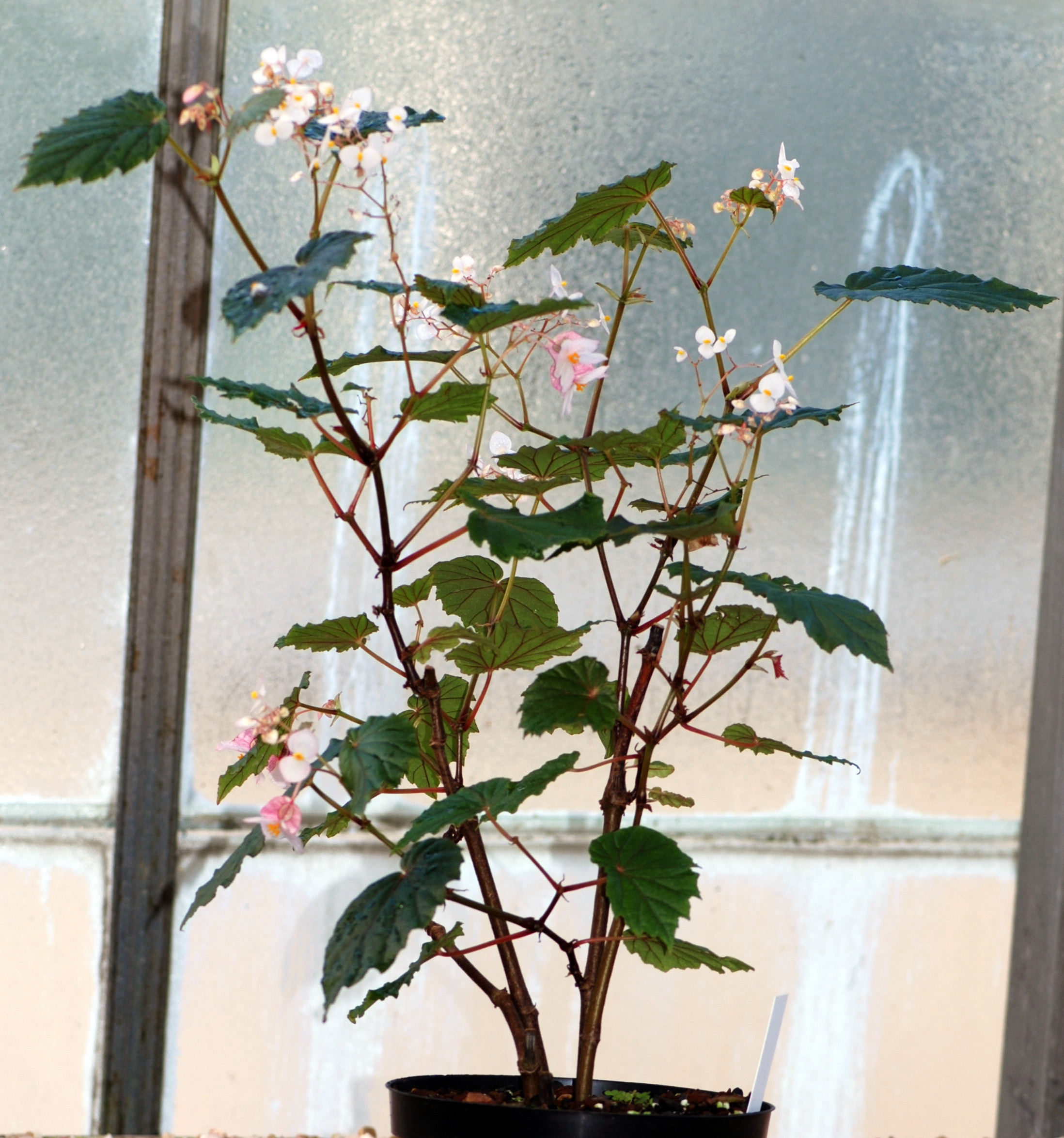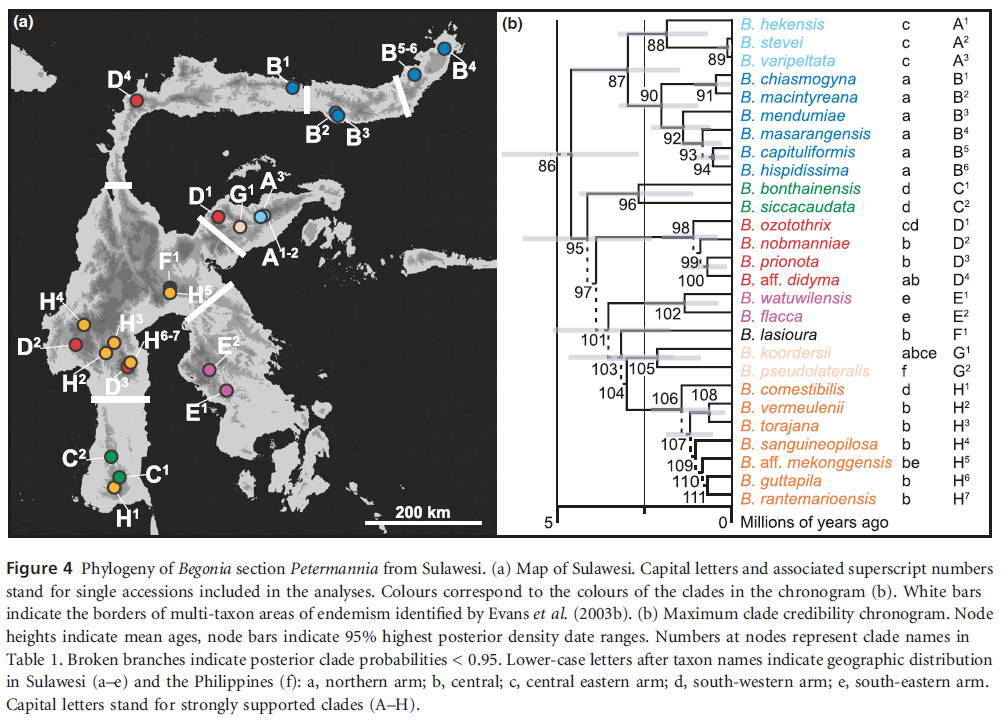Begonia macintyreana in Edinburgh J. Bot. 63(2-3): 194. 2006
Primary tabs

Diagnosis
- A Begonia imperfecta Irmsch. omnino glaberrima (haud secus venos ferruginea), tepalis masculis ad apices acutis, et inflorescentia cymosa (haud subumbellata) recedit. - Type: Sulawesi, Gorontalo, near Tulabolo, in dense shade on steep bank near track in disturbed secondary forest, 177 m, 4 iv 2002, M. Mendum, H.J. Atkins, M.F. Newman, Hendrian & A. Sofyan 2 (holo E; iso E, L). (Four new species of Begonia (Begoniaceae) from Sulawesi. Edinburgh J. Bot. 63.: 191-199. 2006.)
Description
- Erect glabrous branching herb to c.80 cm high.
Stem woody at base, c.12 mm across, internodes 5-8 cm.
Stipules 10 × 8 mm, broadly lanceolate with a filiform extension at the tip, semi-persistent. Petioles 4-7 cm long. Leaves very asymmetric, up to c.15 cm long from base to tip and up to 7 cm wide, midrib 6-10 cm, ovate-lanceolate with an acute tip, margin scalloped and denticulate, cordate at the base, deep glossy green above and pale grey-green below.
Inflorescence bisexual, terminal or axillary, protogynous; bracts lanceolate, 3 mm long, deciduous.
Male flowers borne distally to the female in a monochasial cyme usually comprised of three main axes each with c.30 male flowers; tepals 2, 12 × 12 mm, shield shaped, base sub-cordate to truncate, apex slightly pointed, white; stamens c.35, yellow, anthers c.0.75 mm long, dehiscing through slits c.half as long as the anther, filaments up to twice as long, slightly fused at the base.
Female flowers borne in pairs at the base of the inflorescence; pedicels c.12 mm long; tepals 5, equal, ovate-lanceolate, 20 × 13 mm, white to palest pink; styles 3, twice spirally twisted, orange, deciduous; ovary 12 × 18 mm with 3 equal wings, obtusely indented across the apex, pale pink with darker venation, placentation axile, placentae bifid, wings rounded at the base, acute at the tip, extended distally.
Fruit 15 × 22 mm, drying pale brown, dehiscent; capsule oval, 8 × 5 mm. Seeds barrel shaped, c.0.3 mm long, collar cells c.2/3 the length of the seed. (Four new species of Begonia (Begoniaceae) from Sulawesi. Edinburgh J. Bot. 63.: 191-199. 2006.)
Habitat
- This species was observed growing on a steep bank in secondary forest, in full shade, at c.180 m above sea level.
Conservation
- Proposed IUCN category: VU D2. (Four new species of Begonia (Begoniaceae) from Sulawesi. Edinburgh J. Bot. 63.: 191-199. 2006.)
- Data Deficient (DD). This species is known from only two collections, both of which were collected at the border of the Bogani Nani Wartabone National Park. There is no available information about current threats, habitat conditions and population sizes. Furthermore, the forests in the wider area of the national park are very poorly collected. Consequently, we assess this species as Data Deficient (IUCN Standards and Petitions Subcommittee, 2019). (Ardi, W.H. & Thomas, D.C. 2022: Synopsis of Begonia (Begoniaceae) from the northern arm of Sulawesi and Sangihe Island, Indonesia, including three new species. – Edinburgh J. Bot. 79(Begonia special issue, article 405): 1-50. http://doi.org/10.24823/EJB.2022.405)
Distribution
Indonesia: endemic to Sulawesi, North and Gorontalo Provinces
See specimen images for distribution map (Ardi, W.H. & Thomas, D.C. 2022: Synopsis of Begonia (Begoniaceae) from the northern arm of Sulawesi and Sangihe Island, Indonesia, including three new species. – Edinburgh J. Bot. 79(Begonia special issue, article 405): 1-50. http://doi.org/10.24823/EJB.2022.405)
See specimen images for distribution map (Ardi, W.H. & Thomas, D.C. 2022: Synopsis of Begonia (Begoniaceae) from the northern arm of Sulawesi and Sangihe Island, Indonesia, including three new species. – Edinburgh J. Bot. 79(Begonia special issue, article 405): 1-50. http://doi.org/10.24823/EJB.2022.405)
Etymology
- It is named in honour of Mr and Mrs Malcolm L. MacIntyre, the founders of the M. L. MacIntyre Begonia Trusts, which have facilitated much research into the genus.
Notes
- In cultivation this species forms a splendid hemispherical mound nearly a metre across, and has a long flowering period. The scalloped edge to the leaf is characteristic of many species of Begonia from Sulawesi. (Four new species of Begonia (Begoniaceae) from Sulawesi. Edinburgh J. Bot. 63.: 191-199. 2006.)
- The species is characterised by a character combination including: an erect growth habit; a glabrous stem; ovate, bullate leaf lamina; complexly branching male inflorescences (a compound thyrse with monochasial partial inflorescences) with numerous flowers; and female flower tepals that are ovate to lanceolate and have an acute apex. (Ardi, W.H. & Thomas, D.C. 2022: Synopsis of Begonia (Begoniaceae) from the northern arm of Sulawesi and Sangihe Island, Indonesia, including three new species. – Edinburgh J. Bot. 79(Begonia special issue, article 405): 1-50. http://doi.org/10.24823/EJB.2022.405)
Molecular Systematics
- GenBank
- see Thomas et al., 2012 (Thomas, D.C., Hughes, M., Phutthai, T., Ardi, W.H., Rajbhandary, S., Rubite, R., Twyford, A.D. & Richardson, J.E. 2012: West to east dispersal and subsequent rapid diversification of the mega-diverse genus Begonia (Begoniaceae) in the Malesian archipelago. – Journal of Biogeography 39: 98-113)
 |
Specimens
- Indonesia. Sulawesi. Northern arm of Sulawesi. Central North Sulawesi: Dumoga Bone National Park, Suwawa District, 27 xii 1994, JJ. Afriastini & Rohajawati JJA2918 (E, K). Eastern North Sulawesi: Sulawesi Utara, 27 xii 1994, J. Juanda 22 (K). (Ardi, W.H. & Thomas, D.C. 2022: Synopsis of Begonia (Begoniaceae) from the northern arm of Sulawesi and Sangihe Island, Indonesia, including three new species. – Edinburgh J. Bot. 79(Begonia special issue, article 405): 1-50. http://doi.org/10.24823/EJB.2022.405)


